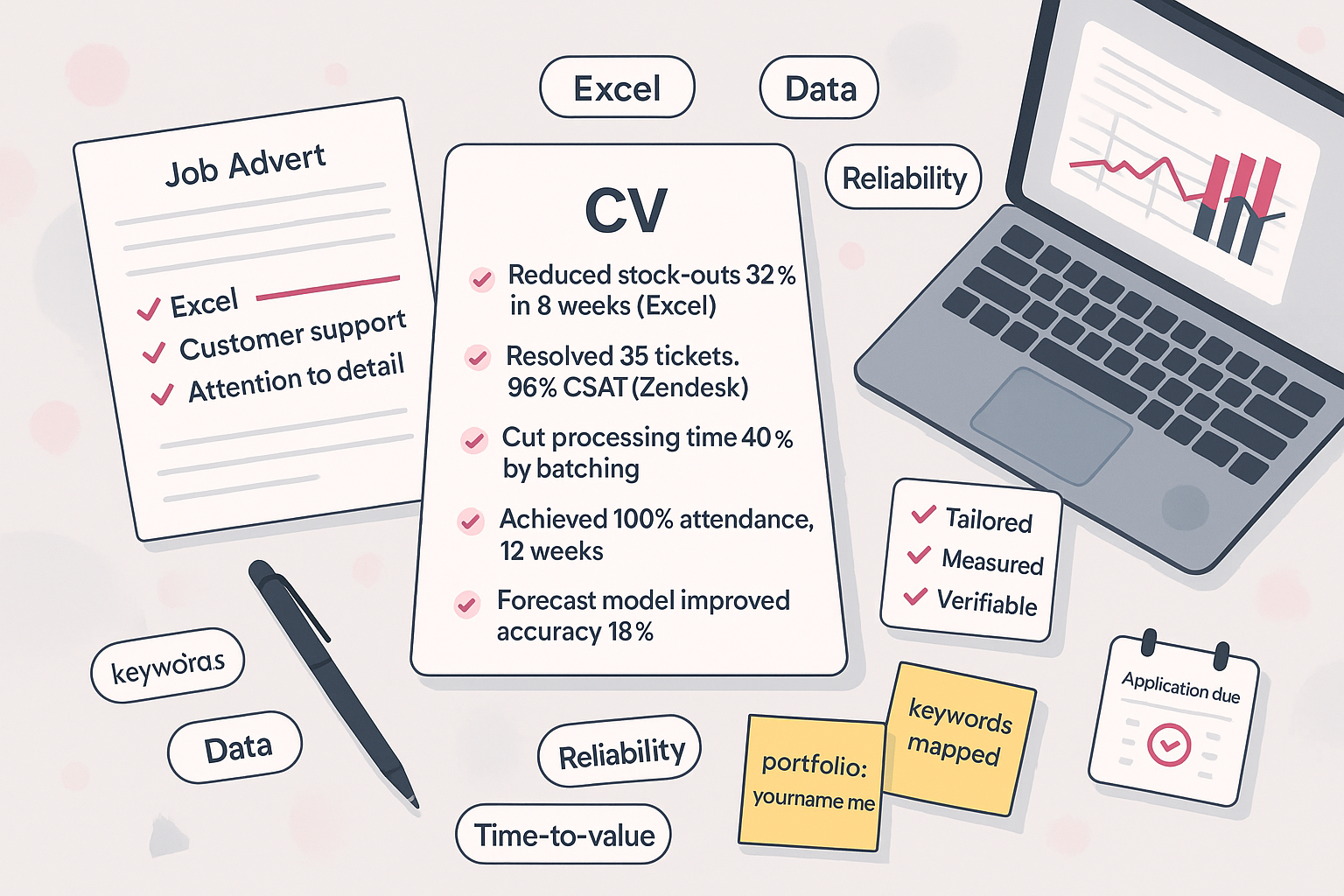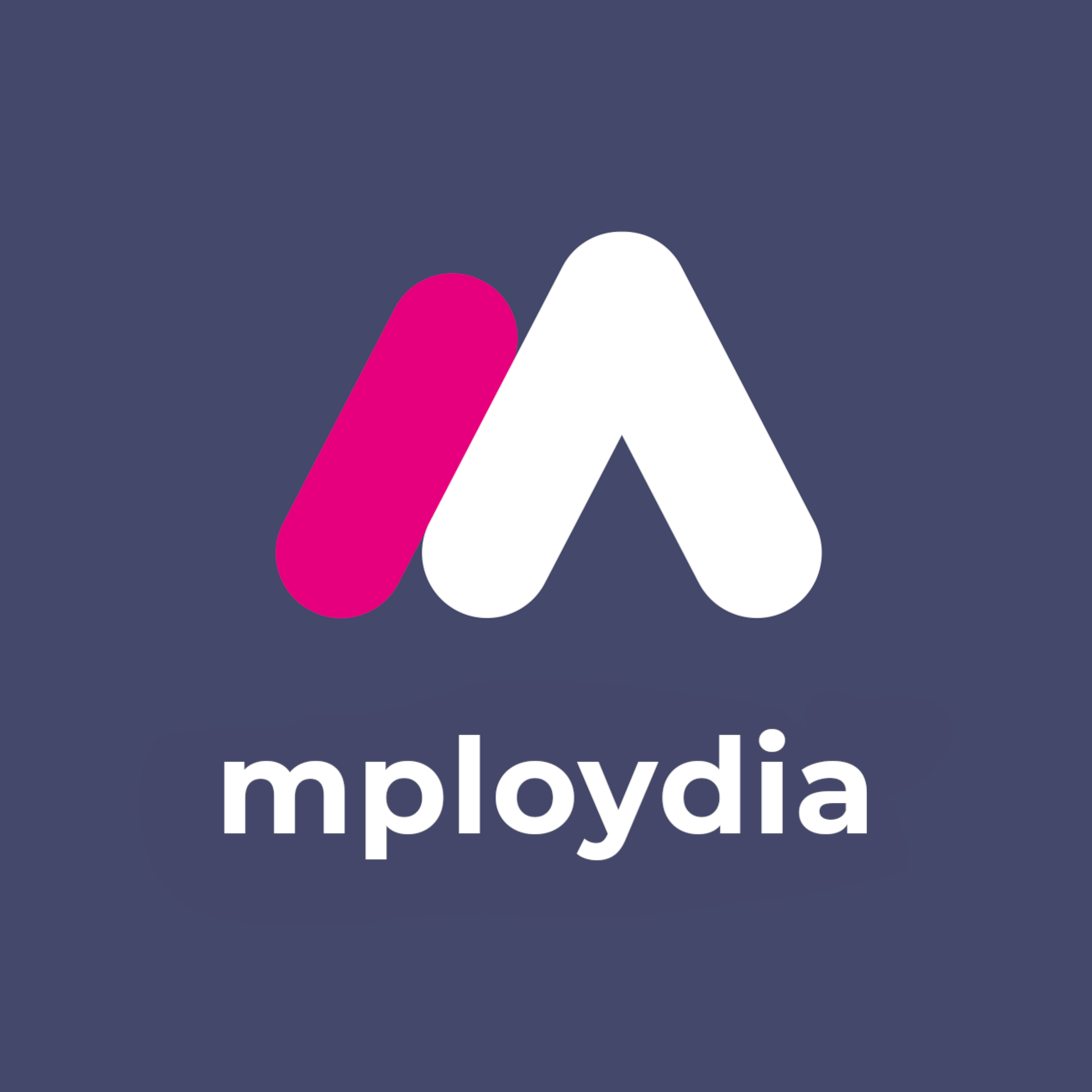
First Job CV Proof Points Employers Notice, Trust and Act On
What is a CV proof point?
If you’re applying for your first job, you cannot rely on claims. Employers skim, judge, and decide in seconds. Proof beats promise. This article shows you exactly how to build hard proof points that make a CV unignorable, even with zero formal experience.
A CV proof point is a one-line piece of evidence that shows you delivered a result, at a clear standard, in a real context. It turns vague responsibilities into measurable outcomes. It answers three questions fast: What did you do? How well? Why should I believe you?
The formula and checklist
Use this structure every time: Strong verb + task + metric + tool/technique + context + time frame + outcome/value. Example: “Reduced stock-outs by 32% in 8 weeks by auditing deliveries daily and updating reorder levels in Excel, improving on-shelf availability.”
- Does it start with a strong verb (reduced, increased, delivered, built, analysed, automated)?
- Is there at least one number (percentage, count, time, £, frequency, accuracy)?
- Is the tool or method named (Excel, Canva, SQL, Trello, POS, Zendesk)?
- Is there a time frame (in 2 weeks, across 3 months, during peak season)?
- Is the value obvious (saved time, reduced errors, improved satisfaction, increased sales)?
Where to find proof if it’s your first job
You have more evidence than you think. Employers don’t only care about paid experience. They care about credible evidence of performance.
Sources of proof
- Coursework and capstone projects
- Group assignments and student societies
- Volunteering and community roles
- Part-time or seasonal work
- Personal projects and portfolios
- Sports teams and coaching
- Hackathons, case competitions, and challenges
- Freelance or gig work
- Caregiving and family responsibilities
- Online courses, certifications, and badges
- Content creation, blogs, or public speaking
- Entrepreneurship, side hustles, or marketplaces
Turn each source into numbers
- Scale: number of people served, items handled, orders processed
- Speed: turnaround time, response time, delivery time
- Quality: accuracy rate, error reduction, first-time-right
- Reliability: attendance rate, on-time rate, shift coverage
- Impact: £ saved, revenue generated, engagement uplift, satisfaction score
- Growth: followers gained, sign-ups, conversion rate
- Efficiency: tasks automated, steps removed, hours saved
Map proof points to the job advert
Your proof must point at their needs, not your history.
Fast mapping process
- Highlight every requirement in the job advert.
- For each, write one proof bullet that demonstrates you can do it.
- Use exact keywords and tools from the advert for ATS alignment.
- Put the strongest, most relevant proof bullets at the top of each section.
The 12 proof themes employers want (with examples)
1) Reliability and ownership
- Achieved 100% attendance across a 12-week retail placement, called in early to cover 7 peak shifts without prompting.
- Closed cash drawer with zero discrepancies across 45 shifts, following end-of-day checklist precisely.
2) Speed and efficiency
- Cut email response time from 24 hours to under 4 hours by triaging queries in shared inbox and using saved templates.
- Picked and packed 65 orders per shift with 0 errors by batching SKUs and verifying barcodes at each stage.
3) Accuracy and quality
- Reconciled 150+ records weekly with 99.8% accuracy using Excel VLOOKUP and conditional formatting.
- Produced 12 social posts per week with error-free copy and brand-consistent formatting after building a pre-publish checklist.
4) Initiative and problem solving
- Identified a 14% basket abandonment on mobile; simplified checkout copy and moved key CTA, increasing completion by 7% in 3 weeks.
- Built a rota template in Google Sheets that cut scheduling time by 40 minutes weekly for the volunteer team lead.
5) Customer impact
- Resolved 30+ support tickets weekly in Zendesk with 95% CSAT by following a 3-step clarification script.
- Increased café table turn by 12% during lunch rush by pre-bussing and reorganising condiments to reduce wait time by 3 minutes.
6) Teamwork and communication
- Coordinated a 6-person project team using Trello, delivering a 20-page report 2 days early with all stakeholders sign-off.
- Facilitated daily 10-minute stand-ups, cutting duplicated work by 25% and improving task clarity.
7) Learning agility
- Completed Google Data Analytics Certificate in 6 weeks, applying pivot tables to analyse 2,000-row dataset and present findings.
- Learned POS system in one shift, then trained 3 colleagues using a one-page quick-start guide.
8) Digital and data fluency
- Built a 3-sheet Excel model with formulas and charts to forecast demand, improving ordering accuracy by 18%.
- Automated weekly Instagram insights export and summary, reducing manual reporting time by 90% using a simple macro.
9) Commercial awareness
- Suggested moving a low-margin SKU from end-cap to shelf, increasing high-margin alternative sales by 9% week-on-week.
- Negotiated a 10% discount on supplies by consolidating orders with a nearby partner group.
10) Organisation and prioritisation
- Managed 5 overlapping coursework deadlines with a calendar and a 2-hour daily focus block, delivering all submissions on time.
- Cleared a 50-ticket backlog by triaging by impact, resolving 80% within 48 hours.
11) Leadership without title
- Mentored 2 new volunteers, reducing their onboarding time from 3 weeks to 10 days with a buddy checklist.
- Led safety briefing for 12-person shift after a process change, achieving full compliance on day one.
12) Integrity and safety
- Maintained GDPR-compliant handling of 300+ customer entries in a raffle using locked spreadsheet and anonymised IDs.
- Passed Level 2 Food Hygiene and kept temperature logs accurate over a 6-week festival period.
Where to place proof points on your CV
Use proof where it gets read first and where ATS can parse it.
Profile summary
- One or two lines with quantified credibility. Example: “Entry-level analyst who reduces errors and improves speed. Cut stock count time by 35% using Excel checks. Google Data Analytics certified.”
Experience section
- For each role or activity, list 3–6 bullets using the formula. Put the most relevant first.
Projects section
- Add 2–4 projects with one-line outcomes. Include links if allowed. Example: “Analysed 12 months of sales data; identified 3 SKUs driving 60% of returns; recommended bundle change.”
Skills with proof
- Don’t just list tools. Give a metric. Example: “Excel: built a 1,500-row VLOOKUP reconciliation with 99.8% accuracy.”
Education and certifications
- Add modules, grades where strong, and relevant coursework outcomes. Include credible micro-credentials.
Achievements and awards
- Add competitions, scholarships, hackathons, and top placements with ranks or numbers.
Links and portfolios
- Link to LinkedIn, portfolio, GitHub, or a one-page evidence sheet. Ensure links are clean and active.
References and testimonials
- If you have a short quote, include it as a single line in Achievements. Example: “Shift lead: ‘Most reliable new starter this quarter.’”
Phrases to delete and what to write instead
Delete these weak claims:
- “Hardworking team player”
- “Strong communication skills”
- “Detail-oriented”
- “Responsible for…”
Replace with proof:
- “Covered 7 peak shifts at short notice; 100% on-time starts.”
- “Presented weekly findings to 20 peers; Q&A resolved all objections.”
- “Achieved 99.8% accuracy across 1,200 entries; zero rework.”
- Use “Delivered” or “Reduced” instead of “Responsible for.”
Make proof verifiable and honest
Trust comes from traceability. If asked, you must show how you got the number.
Verification checklist
- Keep a simple evidence log: date, activity, metric, source.
- Save screenshots, spreadsheets, or links that back up claims.
- Use conservative rounding and avoid inflated percentages.
- Attribute team wins correctly. State your specific contribution.
- Be ready to talk through your method step by step.
ATS and formatting tips for proof points
- Use a clean, single-column layout with clear headings.
- Use standard section titles: Profile, Experience, Education, Projects, Skills, Certifications, Achievements.
- Mirror keywords from the job advert, especially tools and role titles.
- Keep bullet points to 1–2 lines each. Avoid dense paragraphs.
- Include numerals for numbers (25, not twenty-five) and symbols (£, %, +) where appropriate.
- Save as PDF unless the employer requests Word. Use a clear file name: Firstname-Lastname-CV.pdf.
Sector-specific mini templates you can copy
Retail associate
- Increased on-shelf availability by 12% in 6 weeks by auditing gaps twice daily and updating reorder levels in POS.
- Processed 55+ transactions per shift with zero till errors by following a 6-step cash-up checklist.
Hospitality crew
- Cut average wait time by 3 minutes during lunch by reorganising prep station and pre-batching top 5 items.
- Maintained 5-star hygiene audit for 8 weeks by enforcing labelling and temperature logs.
Customer support
- Resolved 35 tickets weekly with 96% satisfaction by using a 3-message escalation rule in Zendesk.
- Reduced repeat contacts by 22% by adding a self-serve FAQ and tagging common issues.
Administrative assistant
- Cleared a 200-email backlog in 5 days by triaging with labels and creating templates for the top 6 query types.
- Scheduled 40+ appointments weekly with zero clashes using Outlook shared calendars and a confirmation script.
Marketing assistant
- Grew Instagram engagement by 28% in 60 days by testing 3 post formats and optimising posting times from insights.
- Produced a monthly report in Google Data Studio that cut manual work by 3 hours per cycle.
Junior software or data
- Built a Python script that cleaned a 10,000-row dataset, reducing manual prep time by 80% and improving accuracy.
- Implemented input validation that cut user errors by 35% across 2 forms; documented in GitHub with tests.
Logistics and warehousing
- Picked 120 orders per shift at 99.5% accuracy by double-scanning barcodes and batching by aisle route.
- Reduced damages by 18% by redesigning packing sequence for fragile items and training the team.
Finance or accounts assistant
- Reconciled 3 accounts weekly with 100% on-time closes using Excel pivot tables and bank rules.
- Caught a recurring £240 monthly overcharge by auditing vendor invoices and updating the PO process.
Healthcare support
- Monitored 12 patients per shift, logging vitals on schedule with zero missed entries.
- Improved patient comfort scores by 15% by standardising room setup and checking in every 30 minutes.
How to build metrics when none are tracked
If your environment didn’t track metrics, start tracking yourself.
- Count volume for a week: items handled, people served, hours saved.
- Time tasks before and after an improvement to show delta.
- Sample accuracy: check 50 records, count errors, fix root causes.
- Survey satisfaction with a simple 1–5 rating from users or teammates.
- Compare to a baseline: last week, previous month, similar shift.
Upgrade any weak bullet in 60 seconds
- Find the verb. If it starts with “Responsible for,” change it to “Delivered,” “Reduced,” or “Increased.”
- Add a number. Even a rough, honest count is better than none.
- Add the tool. Name the system or method.
- Add time. Over what period?
- Add value. Why it mattered.
Before: “Responsible for social media posts.”
After: “Published 3 posts weekly for 8 weeks, increasing average engagement by 28% by testing captions and timing from insights.”
Proof your soft skills with hard data
- Communication: “Presented findings to 20 peers; answered all questions; proposal approved.”
- Teamwork: “Coordinated 6-person team; delivered report 2 days early; zero late tasks.”
- Time management: “Met 5 concurrent deadlines over 3 weeks with a daily 2-hour focus block.”
- Adaptability: “Learned new POS in 1 shift; trained 3 peers using a one-page guide.”
- Initiative: “Created a checklist that cut errors by 40%; adopted by full shift.”
Proof point do’s and don’ts
Do
- Lead with outcomes. Tools and tasks come after results.
- Be specific and brief. One idea per bullet.
- Prioritise relevance to the target job.
- Use industry language used in the advert.
- Keep numbers honest and traceable.
Don’t
- List duties without impact.
- Pad with clichés or buzzwords without proof.
- Inflate percentages with tiny denominators.
- Hide your best evidence in the second page.
- Forget to update bullets per application.
Build your 7-day proof bank
- Day 1: Collect everything. Modules, projects, volunteering, part-time jobs, competitions, content, certifications.
- Day 2: List tasks and outcomes for each experience.
- Day 3: Add numbers. Estimate carefully where needed and note the source.
- Day 4: Match evidence to 3 target roles. Highlight overlaps.
- Day 5: Write 20 proof bullets using the formula.
- Day 6: Edit ruthlessly. Remove anything without a number or clear value.
- Day 7: Share with a trusted reviewer. Stress-test for clarity, honesty, and relevance.
Frequently asked questions
What if my number is a team result? State your specific contribution. Example: “Team increased sales by 12%; led product display change that lifted conversion on 2 key SKUs.”
What if I don’t have formal experience? Use projects, volunteering, learning, and personal initiatives. Show real outputs and outcomes.
What if I can’t share exact figures? Use ranges or percentages. “Reduced handling time by about 25% over 3 weeks” beats no data.
What if I’m changing fields? Translate outcomes. Speed, accuracy, reliability, customer impact, and learning agility are universal.
Final check before you submit
- Top 50% of your CV is loaded with the strongest proof.
- Every bullet follows the formula and has a number.
- Keywords match the job advert.
- Links work on desktop and mobile.
- File name is professional. PDF is under 2 MB.
Bottom line
Your first job CV needs evidence, not adjectives. Build proof points that show results, speed, accuracy, initiative, and impact. Map them to the job. Make them verifiable. If you do this well, you will get noticed, you will get interviews, and you will have talking points that make you memorable in the room.
Next Steps
Want to learn more? Check out these articles:
Write Impact Statements Not Duties on Your CV to Get Hired
Show You’re Job-Ready With No Experience: 10 Proven Tactics
Decode Job Adverts for Fit: The Practical Graduate's Guide
Check out our Advanced Employability Course for all the help you need to get your dream job, fast.


